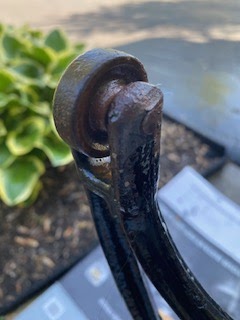After using the Restore A Finish on the wood, it was time to tackle the iron parts of the treadle. The black wrought iron was kinda tricky. Given that I don't have a way to sand blast all the bits to remove all the clear coat and black paint, I had to figure out what I could do.
The iron parts were in pretty good shape but a good scrub with soap and water and a wire brush was needed. As I was cleaning the parts, I realized there was a bit of rust on the wheels and on the underside of the pedal and a few other places. I also realized that during this scrub the pitman rod on my machine was actually wood and not iron. It was completely black and I had no idea. So when it started to turn a rusty brown color I thought rust until it looked more brown and I realized it was wood.
So I had to take the entire thing a part, which I was trying to avoid, but it was necessary. I cleaned up the wood rod and used the Howard products on it to match the cabinet.
I also discovered that there was gold painting on the Singer side medallions and across the center iron. I wasn't sure if the medallions were originally painted gold or because that's what people like doing today and I guess some of the medallions were originally painted gold and some were not. But as I cleaned the irons, the gold paint was clearly visible.
Original gold paint found
I used Rustoleum Rust converter all over the irons. I wasn't sure if I could see all the little rust spots and I just thought I'd be thorough so I painted all the irons all over with the converter. Now, I probably didn't have to do that but it was just to be on the safe side but then I worried that coating of converter would interfere with the paint adhering to the irons. So I decided to take a bit of sandpaper and rough up the finish a bit and that was probably a mistake.
Before rust converter
Almost immediately, there was large flakes of what I assume is the lacquer that was used as a clear coat but it could've been shellac. I'm not sure what they used but whatever it was it started peeling. And when I pulled it off, it was kind of a dirty yellowish color and the more I looked it appeared to look like spider web cracking look across the black. So, I decided that I wasn't going to add paint to something that looks like it could peel right off and decided to take off whatever was peeling off. So I started sanding and peeling the coating off and after 3 or 4 days, I was finally done. It was a really messy job and I'm not sure I had to do that but I did.
Next, I had to wait for a warm day with the right level of humidity which took about a week. I used Rustoleum black on all the iron bits and hand painted the gold medallion and center Singer with antique gold Rub'n Buff. I found the Rustoleum products at my local Lowe's and I just read the directions on the can regarding weather/condition requirements. I used Rustoleum satin clear coat on everything.
I was surprised that it didn't take me long at all to hand paint the medallions. Some of the embossed lettering was easy and some was fairly flat and hard to paint but it only took me about 2 hours. The gold paint didn't need thinning but it dried fairly quickly. Just use little bits at a time. This is a very tiny tube of paint so don't squeeze it all out.









Comments
Post a Comment